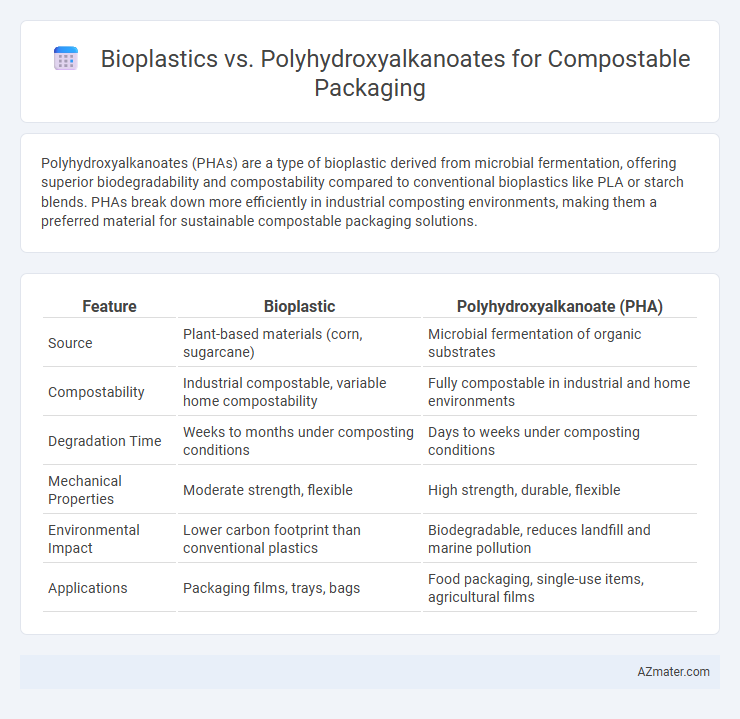Polyhydroxyalkanoates (PHAs) are a type of bioplastic derived from microbial fermentation, offering superior biodegradability and compostability compared to conventional bioplastics like PLA or starch blends. PHAs break down more efficiently in industrial composting environments, making them a preferred material for sustainable compostable packaging solutions.
Table of Comparison
| Feature | Bioplastic | Polyhydroxyalkanoate (PHA) |
|---|---|---|
| Source | Plant-based materials (corn, sugarcane) | Microbial fermentation of organic substrates |
| Compostability | Industrial compostable, variable home compostability | Fully compostable in industrial and home environments |
| Degradation Time | Weeks to months under composting conditions | Days to weeks under composting conditions |
| Mechanical Properties | Moderate strength, flexible | High strength, durable, flexible |
| Environmental Impact | Lower carbon footprint than conventional plastics | Biodegradable, reduces landfill and marine pollution |
| Applications | Packaging films, trays, bags | Food packaging, single-use items, agricultural films |
Introduction to Compostable Packaging
Compostable packaging is designed to break down into natural elements within a compost environment, reducing plastic pollution and supporting sustainable waste management. Bioplastics, derived from renewable biomass, and polyhydroxyalkanoates (PHAs), a specific family of bioplastics produced by bacterial fermentation, are key materials in this field. PHAs offer superior biodegradability and compostability compared to conventional bioplastics, making them highly effective for eco-friendly packaging solutions.
What Are Bioplastics?
Bioplastics are a category of materials derived from renewable biomass sources such as corn starch, sugarcane, or cellulose, designed to reduce reliance on fossil fuels and lower carbon footprints. These materials can be either biodegradable or non-biodegradable, with compostable variants specifically formulated to decompose under industrial or home composting conditions. Polyhydroxyalkanoates (PHAs) are a subclass of bioplastics produced by microbial fermentation of organic substrates, offering superior compostability and compatibility with sustainable packaging solutions.
Understanding Polyhydroxyalkanoates (PHA)
Polyhydroxyalkanoates (PHAs) are a family of biodegradable polyesters produced by microbial fermentation of sugars or lipids, making them a sustainable alternative to conventional bioplastics derived from petrochemicals. Their unique properties, such as high biodegradability in various environments including marine and soil conditions, position PHAs as ideal materials for compostable packaging applications. The ability of PHAs to fully decompose into non-toxic byproducts without leaving harmful residues distinguishes them from many other bioplastics, enhancing their environmental benefits in circular economy models.
Raw Materials and Production Processes
Polyhydroxyalkanoates (PHAs) are bioplastics derived from microbial fermentation of renewable raw materials such as sugar, starch, and vegetable oils, using bacteria that produce PHAs as intracellular carbon storage. Traditional bioplastics often originate from plant-based feedstocks like corn or sugarcane through chemical polymerization processes that may involve extensive energy and solvent use. The production of PHAs generally involves sustainable biodegradable polymer synthesis in controlled bioreactors, offering a more environmentally friendly alternative due to less reliance on petrochemical inputs and improved compostability in diverse waste management systems.
Environmental Impact Comparison
Polyhydroxyalkanoate (PHA) bioplastics offer a significantly lower environmental footprint compared to conventional bioplastics due to their complete biodegradability in marine, soil, and compost environments. Unlike many other bioplastics, PHAs are produced by bacterial fermentation of renewable resources, resulting in reduced greenhouse gas emissions and lower reliance on fossil fuels. Life cycle assessments indicate that PHA packaging reduces carbon emissions and accelerates composting rates, supporting sustainable waste management and minimizing landfill accumulation.
Biodegradability and Compostability
Bioplastic and polyhydroxyalkanoate (PHA) both offer sustainable alternatives for compostable packaging, with PHA exhibiting superior biodegradability due to its microbial synthesis and natural polymer structure. PHA breaks down efficiently in both industrial and home composting environments within months, whereas many conventional bioplastics require specific conditions to degrade fully. The enhanced compostability of PHA supports reduced environmental impact and promotes circular economy practices in packaging solutions.
Functional Properties for Packaging
Polyhydroxyalkanoates (PHAs) exhibit superior barrier properties against moisture and oxygen compared to conventional bioplastics, enhancing the shelf life of compostable packaging. PHAs offer excellent mechanical strength and flexibility, making them suitable for various packaging applications requiring durability and resistance to stress. Their biodegradability in both industrial and home composting environments further supports eco-friendly packaging solutions while maintaining functional performance.
Market Adoption and Availability
Polyhydroxyalkanoates (PHAs) represent a niche but rapidly growing segment within the bioplastic market, valued for their complete biodegradability and suitability for compostable packaging. Market adoption of PHAs is expanding due to increasing regulatory pressures and consumer demand for sustainable alternatives, yet their higher production costs and limited manufacturing scale restrict widespread availability. In contrast, conventional bioplastics such as polylactic acid (PLA) see broader market penetration supported by established supply chains, though they may fall short in compostability under natural conditions compared to PHAs.
Regulatory Standards and Certifications
Polyhydroxyalkanoate (PHA) bioplastics comply with stringent regulatory standards such as ASTM D6400 and EN 13432, ensuring complete biodegradability in industrial composting facilities. Compared to conventional bioplastics, PHA packaging often attains certifications like OK Compost Industrial and TUV Austriacert, validating their environmental safety and compostability. Regulatory frameworks, including the European Bioplastics Association guidelines and FDA approvals, increasingly favor PHAs for sustainable packaging due to their non-toxicity and robust performance under composting conditions.
Future Trends in Compostable Packaging Technologies
Bioplastic and polyhydroxyalkanoate (PHA) represent key materials driving innovation in compostable packaging technologies, with PHA gaining prominence due to its complete biodegradability and superior performance in diverse environments. Future trends emphasize enhancing the scalability and cost-efficiency of PHA production through advanced microbial fermentation and feedstock optimization, aligning with circular economy principles. Integration of smart compostable packaging embedded with biosensors for real-time degradation monitoring is also anticipated to revolutionize waste management and consumer transparency.

Infographic: Bioplastic vs Polyhydroxyalkanoate for Compostable Packaging
 azmater.com
azmater.com